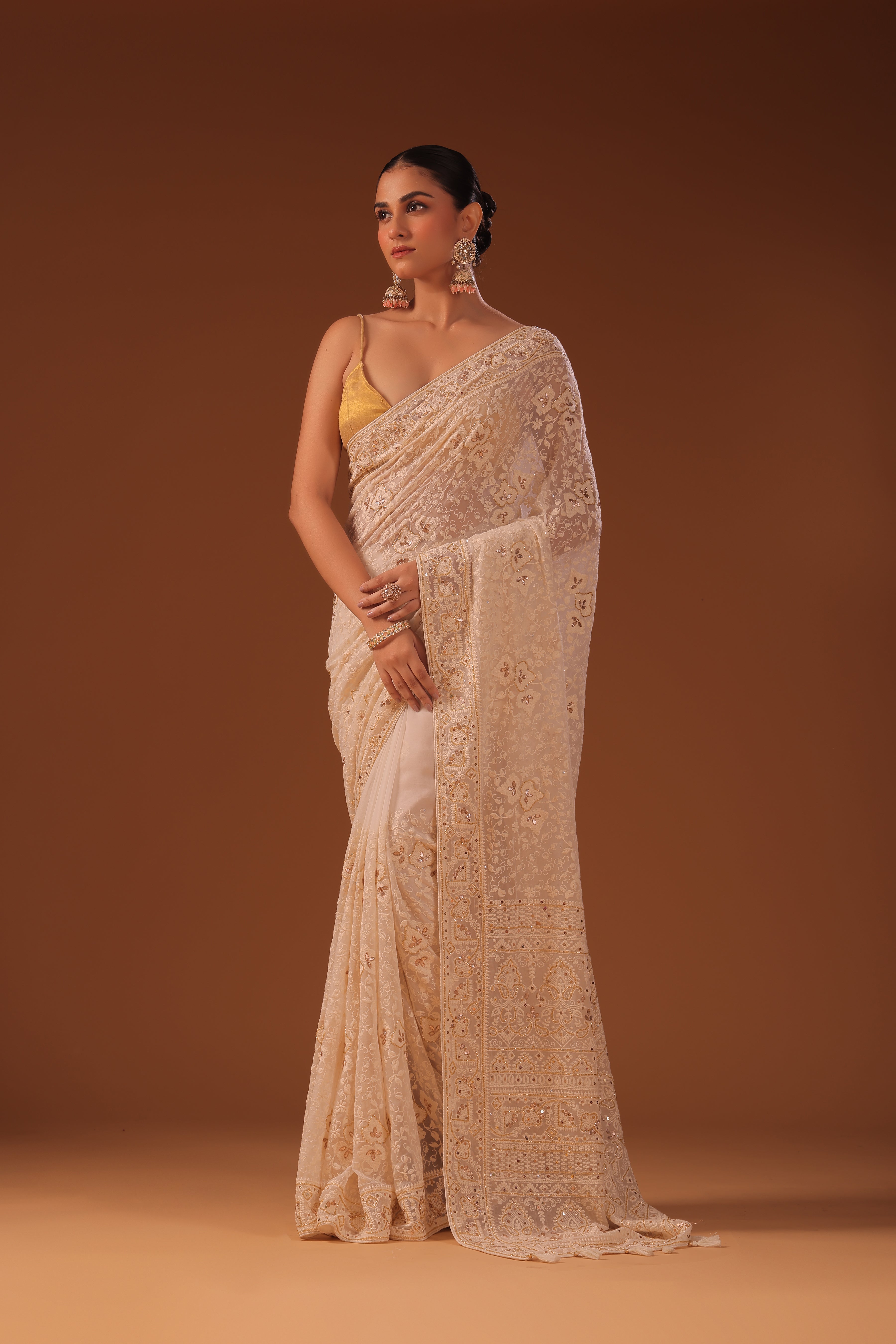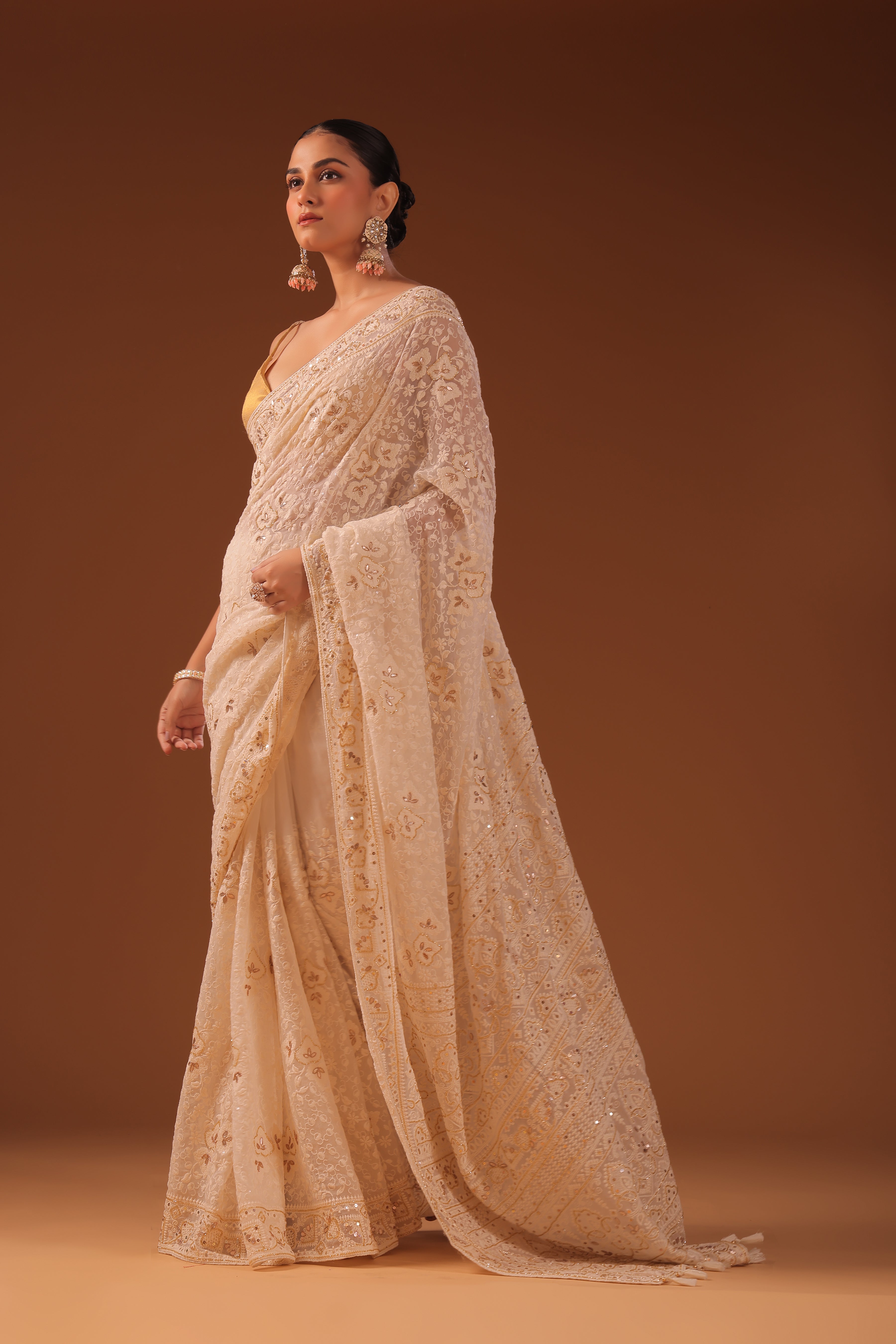A Chikan Saree is a traditional Indian saree embellished with Chikan embroidery, a delicate and intricate hand-embroidery technique that originates from Lucknow, Uttar Pradesh. The Chikan work is known for its fine, airy, and detailed needlework, creating patterns that are often floral, paisley, or geometric. Chikan sarees are highly prized for their intricate craftsmanship, making them popular for formal occasions, weddings, and festive events.
1. Chikan Embroidery
-
Origin: Chikan work, also known as Chikan Kari, is a type of embroidery that has its roots in Lucknow, a city known for its rich cultural heritage and craftsmanship. It dates back to the Mughal era, particularly during the reign of Empress Noor Jahan.
-
Techniques: Chikan embroidery involves several hand-embroidery techniques, including murri, tulip, phanda, jali, and boota. The stitches are usually worked with cotton or silk threads, creating a light, airy, and refined texture.
-
Materials: Chikan embroidery typically uses cotton or silk threads, and sometimes zari (metallic threads), pearls, or sequins to add shimmer and elegance to the design.
-
Patterns: The embroidery motifs commonly found on Chikan work sarees include:
-
Floral patterns: Roses, lotuses, and other intricate flowers.
-
Geometric motifs: Scallops, diamonds, and zigzags.
-
Paisley: An intricate teardrop-shaped design.
-
Vines and leaves: Adding natural elements to the design.
2. Chikan Saree Features
-
Fabric: Chikan sarees are typically made from light fabrics such as georgette, chiffon, net, silk, or cotton. These fabrics provide a soft and elegant drape, perfect for displaying the delicate embroidery.
-
Intricate Embroidery: The hallmark of a Chikan saree is its detailed hand-embroidery. The design can cover the entire saree, with the embroidery starting from the pallu (the loose end of the saree) and extending to the border and pleats. The embroidery can range from light and delicate to dense and bold, depending on the design.
-
Color Palette: Traditionally, white threadwork on white fabric is a classic choice for Chikan sarees, offering a subtle and elegant appearance. However, modern variations can include vibrant colors for both the fabric and the embroidery, such as pastels, bright hues, or even metallic threads for a more contemporary look.
-
Types of Embellishments: Besides threadwork, Chikan sarees can also include embellishments such as stones, pearls, sequins, and zari work to enhance the design and give it a more festive or bridal appearance.
3. Styles of Chikan Sarees
-
Traditional Chikan Sarees: The traditional Chikan saree is often in white or cream fabric with white threadwork. It is known for its light, airy feel and delicate hand-embroidered designs, which lend it a soft, elegant look. These sarees are perfect for casual occasions or day events.
-
Contemporary Chikan Sarees: Modern Chikan sarees come in a variety of colors and fabrics. Georgette, chiffon, and silk sarees are popular choices, offering a glistening finish to complement the embroidery. These sarees can feature bold, colorful threadwork, including floral, geometric, and paisley motifs. This style is often chosen for festive wear and evening events.
-
Bridal Chikan Sarees: Bridal Chikan sarees are a statement piece, typically made from silk or georgette fabric. They often feature intricate, heavy embroidery with zari threads, pearls, and stones to create a regal look. These sarees can be in colors like red, gold, ivory, or pastel shades, and are ideal for weddings, engagements, and other celebratory events.
-
Chikan Net Sarees: These sarees are made from net fabric with Chikan embroidery covering the body or pallu. The transparent nature of the fabric gives a modern twist to the traditional Chikan saree, making it suitable for evening events and cocktail parties.
4. How to Style a Chikan Saree
-
Accessories: Chikan sarees can be paired with simple yet elegant jewelry like pearl earrings, silver bangles, or kada (bracelets). For more elaborate designs, chandbalis (traditional earrings), matha patti, or heavy neckpieces can complement the look.
-
Blouse: The blouse can be designed in a simple or elaborate style, depending on the level of formality. Silk blouses with Chikan embroidery or even a plain blouse with rich borders can match beautifully with the saree.
-
Footwear: Pair the Chikan saree with traditional footwear like juttis, mojris, or kolhapuris for a complete ethnic look. For more formal events, stiletto heels or elegant sandals work well.
-
Hairstyles: A low bun adorned with flowers or a traditional braid with gajra (flower garland) is a popular way to style your hair with a Chikan saree.
5. Where to Wear a Chikan Saree
-
Weddings: Chikan sarees are a popular choice for bridesmaids or guests at weddings, especially those in traditional or royal-themed weddings. Bridal Chikan sarees, with their intricate embroidery, are often worn by brides for their engagements or wedding receptions.
-
Festive Occasions: Whether it’s Diwali, Eid, or Navratri, a Chikan saree can elevate your festive look. The delicate and detailed embroidery makes it perfect for family gatherings and celebrations.
-
Formal Events: Chikan sarees are perfect for formal gatherings, charity events, or galas, where you can show off their elegance and grace.
-
Casual Gatherings: A light Chikan saree can also be worn to more casual events, like brunches or lunches, where the delicate design adds a subtle elegance to your look.
6. Care for Chikan Sarees
-
Dry Cleaning: Due to the delicate nature of the hand-embroidery, it’s recommended to dry clean a Chikan saree rather than machine wash it to preserve its intricate detailing.
-
Storage: Store your Chikan saree in a garment bag or cotton cloth bag to protect the embroidery from dust and accidental snags.
-
Handling: Be gentle when wearing or storing the saree to avoid damaging the fine threads of the Chikan work.
Conclusion
A Chikan saree is a timeless piece of Indian heritage that combines delicate embroidery with elegant fabric to create a sophisticated and graceful look. Whether you choose a traditional white-on-white design or a more vibrant contemporary look, the intricate Chikan work on a saree adds a touch of luxury and charm to any occasion. Whether it's a wedding, festive gathering, or formal event, a Chikan saree will always stand out as a symbol of refinement and artistry.














